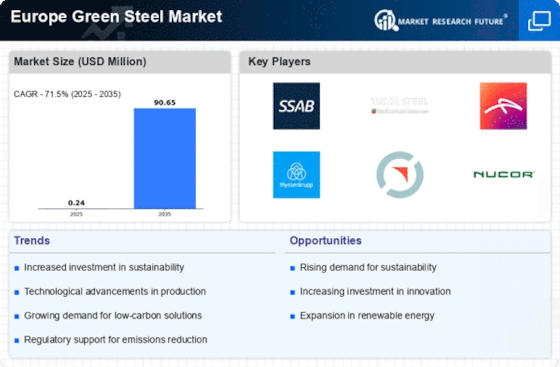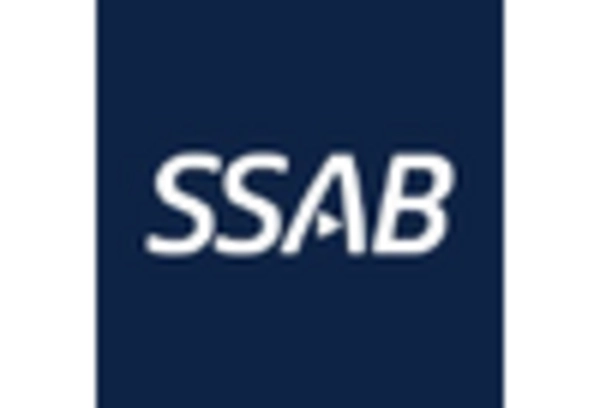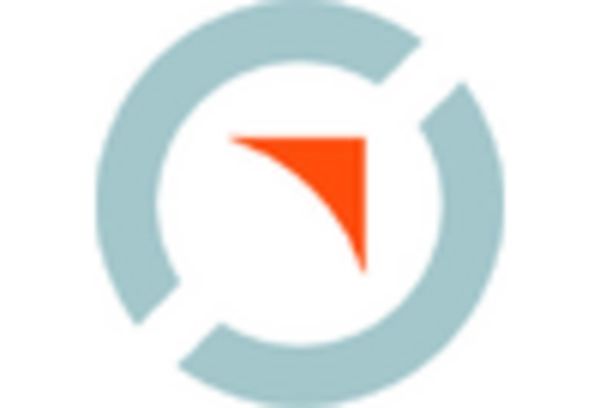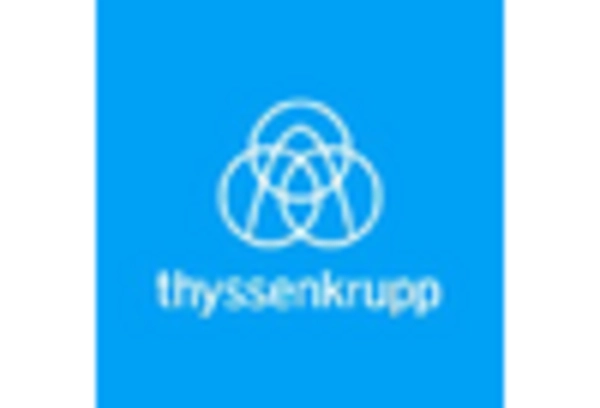Government Initiatives and Policies
The Europe Green Steel Market is significantly influenced by government initiatives and policies aimed at reducing carbon emissions and promoting sustainable practices. Various European nations have implemented stringent regulations that encourage the adoption of green steel production methods. For instance, the European Union's Green Deal aims to make Europe the first climate-neutral continent by 2050, which includes substantial investments in green technologies. These policies not only provide financial incentives for companies to transition to greener practices but also create a favorable regulatory environment for the growth of the green steel sector. As a result, the Europe Green Steel Market is poised for expansion, with governments actively supporting the development of low-carbon steel production technologies.
Rising Corporate Sustainability Goals
The Europe Green Steel Market is witnessing a shift as corporations increasingly adopt sustainability goals within their operational frameworks. Many companies are setting ambitious targets to reduce their carbon emissions and enhance their environmental performance. This trend is particularly evident in sectors that heavily rely on steel, such as automotive and construction, where firms are committing to sourcing green steel to meet their sustainability objectives. As a result, the demand for green steel is expected to rise, with estimates suggesting that the market could grow by over 25 percent annually in the coming years. This alignment of corporate strategies with sustainability principles is likely to propel the Europe Green Steel Market forward, as businesses seek to enhance their competitive advantage through environmentally responsible practices.
Investment in Renewable Energy Sources
The Europe Green Steel Market is increasingly linked to investments in renewable energy sources, which are essential for sustainable steel production. The integration of renewable energy, such as wind and solar power, into steel manufacturing processes is crucial for minimizing carbon footprints. As the cost of renewable energy continues to decline, more steel producers are likely to adopt these energy sources, thereby enhancing the sustainability of their operations. Reports indicate that the share of renewable energy in the European steel sector could reach 50 percent by 2030, significantly impacting the overall emissions profile of the industry. This transition not only supports the objectives of the Europe Green Steel Market but also aligns with broader environmental goals, fostering a more sustainable future for steel production.
Increased Demand for Sustainable Products
The Europe Green Steel Market is experiencing a notable surge in demand for sustainable products, driven by heightened consumer awareness and preferences for environmentally friendly materials. As industries such as automotive and construction increasingly prioritize sustainability, the demand for green steel is projected to rise significantly. According to recent estimates, the market for green steel in Europe could reach approximately 30 million tons by 2030, reflecting a compound annual growth rate of around 20 percent. This shift towards sustainable practices is not merely a trend but appears to be a fundamental change in consumer behavior, compelling manufacturers to adapt their production processes to meet these evolving expectations. Consequently, the Europe Green Steel Market is likely to benefit from this growing demand, as companies strive to align their offerings with the principles of sustainability.
Technological Advancements in Steel Production
Technological advancements are playing a pivotal role in shaping the Europe Green Steel Market. Innovations such as hydrogen-based direct reduction processes and electric arc furnaces are revolutionizing traditional steel production methods, significantly reducing carbon emissions. For example, the implementation of hydrogen in steelmaking could potentially lower emissions by up to 95 percent compared to conventional methods. As these technologies become more commercially viable, they are expected to drive the growth of the green steel market. Furthermore, research and development efforts are likely to yield new solutions that enhance efficiency and sustainability in steel production. Consequently, the Europe Green Steel Market stands to gain from these technological breakthroughs, which may redefine the landscape of steel manufacturing.

















Leave a Comment